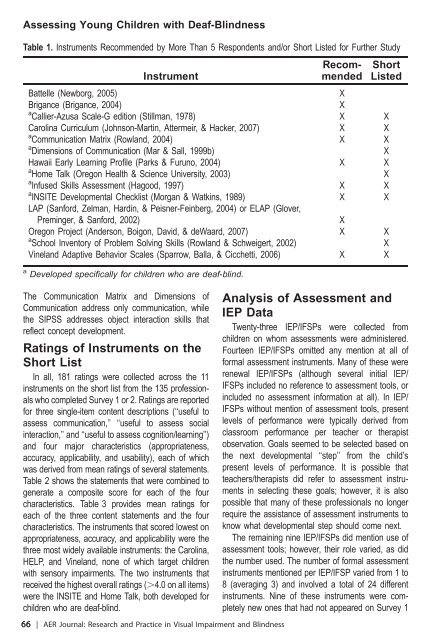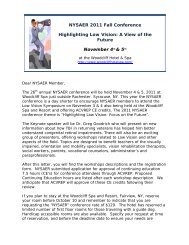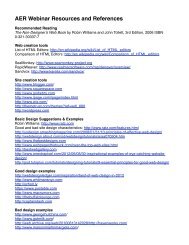Association for Education and Rehabilitation of the ... - AER Online
Association for Education and Rehabilitation of the ... - AER Online
Association for Education and Rehabilitation of the ... - AER Online
You also want an ePaper? Increase the reach of your titles
YUMPU automatically turns print PDFs into web optimized ePapers that Google loves.
Assessing Young Children with Deaf-Blindness<br />
Table 1. Instruments Recommended by More Than 5 Respondents <strong>and</strong>/or Short Listed <strong>for</strong> Fur<strong>the</strong>r Study<br />
Instrument<br />
The Communication Matrix <strong>and</strong> Dimensions <strong>of</strong><br />
Communication address only communication, while<br />
<strong>the</strong> SIPSS addresses object interaction skills that<br />
reflect concept development.<br />
Ratings <strong>of</strong> Instruments on <strong>the</strong><br />
Short List<br />
In all, 181 ratings were collected across <strong>the</strong> 11<br />
instruments on <strong>the</strong> short list from <strong>the</strong> 135 pr<strong>of</strong>essionals<br />
who completed Survey 1 or 2. Ratings are reported<br />
<strong>for</strong> three single-item content descriptions (‘‘useful to<br />
assess communication,’’ ‘‘useful to assess social<br />
interaction,’’ <strong>and</strong> ‘‘useful to assess cognition/learning’’)<br />
<strong>and</strong> four major characteristics (appropriateness,<br />
accuracy, applicability, <strong>and</strong> usability), each <strong>of</strong> which<br />
was derived from mean ratings <strong>of</strong> several statements.<br />
Table 2 shows <strong>the</strong> statements that were combined to<br />
generate a composite score <strong>for</strong> each <strong>of</strong> <strong>the</strong> four<br />
characteristics. Table 3 provides mean ratings <strong>for</strong><br />
each <strong>of</strong> <strong>the</strong> three content statements <strong>and</strong> <strong>the</strong> four<br />
characteristics. The instruments that scored lowest on<br />
appropriateness, accuracy, <strong>and</strong> applicability were <strong>the</strong><br />
three most widely available instruments: <strong>the</strong> Carolina,<br />
HELP, <strong>and</strong> Vinel<strong>and</strong>, none <strong>of</strong> which target children<br />
with sensory impairments. The two instruments that<br />
received <strong>the</strong> highest overall ratings (.4.0 on all items)<br />
were <strong>the</strong> INSITE <strong>and</strong> Home Talk, both developed <strong>for</strong><br />
children who are deaf-blind.<br />
Recommended<br />
Short<br />
Listed<br />
Battelle (Newborg, 2005) X<br />
Brigance (Brigance, 2004) X<br />
a Callier-Azusa Scale-G edition (Stillman, 1978) X X<br />
Carolina Curriculum (Johnson-Martin, Attermeir, & Hacker, 2007) X X<br />
a Communication Matrix (Rowl<strong>and</strong>, 2004) X X<br />
a Dimensions <strong>of</strong> Communication (Mar & Sall, 1999b) X<br />
Hawaii Early Learning Pr<strong>of</strong>ile (Parks & Furuno, 2004) X X<br />
a Home Talk (Oregon Health & Science University, 2003) X<br />
a Infused Skills Assessment (Hagood, 1997) X X<br />
a INSITE Developmental Checklist (Morgan & Watkins, 1989) X X<br />
LAP (San<strong>for</strong>d, Zelman, Hardin, & Peisner-Feinberg, 2004) or ELAP (Glover,<br />
Preminger, & San<strong>for</strong>d, 2002) X<br />
Oregon Project (Anderson, Boigon, David, & deWaard, 2007) X X<br />
a School Inventory <strong>of</strong> Problem Solving Skills (Rowl<strong>and</strong> & Schweigert, 2002) X<br />
Vinel<strong>and</strong> Adaptive Behavior Scales (Sparrow, Balla, & Cicchetti, 2006) X X<br />
a Developed specifically <strong>for</strong> children who are deaf-blind.<br />
66 | <strong>AER</strong> Journal:Research <strong>and</strong> Practice in Visual Impairment <strong>and</strong> Blindness<br />
Analysis <strong>of</strong> Assessment <strong>and</strong><br />
IEP Data<br />
Twenty-three IEP/IFSPs were collected from<br />
children on whom assessments were administered.<br />
Fourteen IEP/IFSPs omitted any mention at all <strong>of</strong><br />
<strong>for</strong>mal assessment instruments. Many <strong>of</strong> <strong>the</strong>se were<br />
renewal IEP/IFSPs (although several initial IEP/<br />
IFSPs included no reference to assessment tools, or<br />
included no assessment in<strong>for</strong>mation at all). In IEP/<br />
IFSPs without mention <strong>of</strong> assessment tools, present<br />
levels <strong>of</strong> per<strong>for</strong>mance were typically derived from<br />
classroom per<strong>for</strong>mance per teacher or <strong>the</strong>rapist<br />
observation. Goals seemed to be selected based on<br />
<strong>the</strong> next developmental ‘‘step’’ from <strong>the</strong> child’s<br />
present levels <strong>of</strong> per<strong>for</strong>mance. It is possible that<br />
teachers/<strong>the</strong>rapists did refer to assessment instruments<br />
in selecting <strong>the</strong>se goals; however, it is also<br />
possible that many <strong>of</strong> <strong>the</strong>se pr<strong>of</strong>essionals no longer<br />
require <strong>the</strong> assistance <strong>of</strong> assessment instruments to<br />
know what developmental step should come next.<br />
The remaining nine IEP/IFSPs did mention use <strong>of</strong><br />
assessment tools; however, <strong>the</strong>ir role varied, as did<br />
<strong>the</strong> number used. The number <strong>of</strong> <strong>for</strong>mal assessment<br />
instruments mentioned per IEP/IFSP varied from 1 to<br />
8 (averaging 3) <strong>and</strong> involved a total <strong>of</strong> 24 different<br />
instruments. Nine <strong>of</strong> <strong>the</strong>se instruments were completely<br />
new ones that had not appeared on Survey 1







